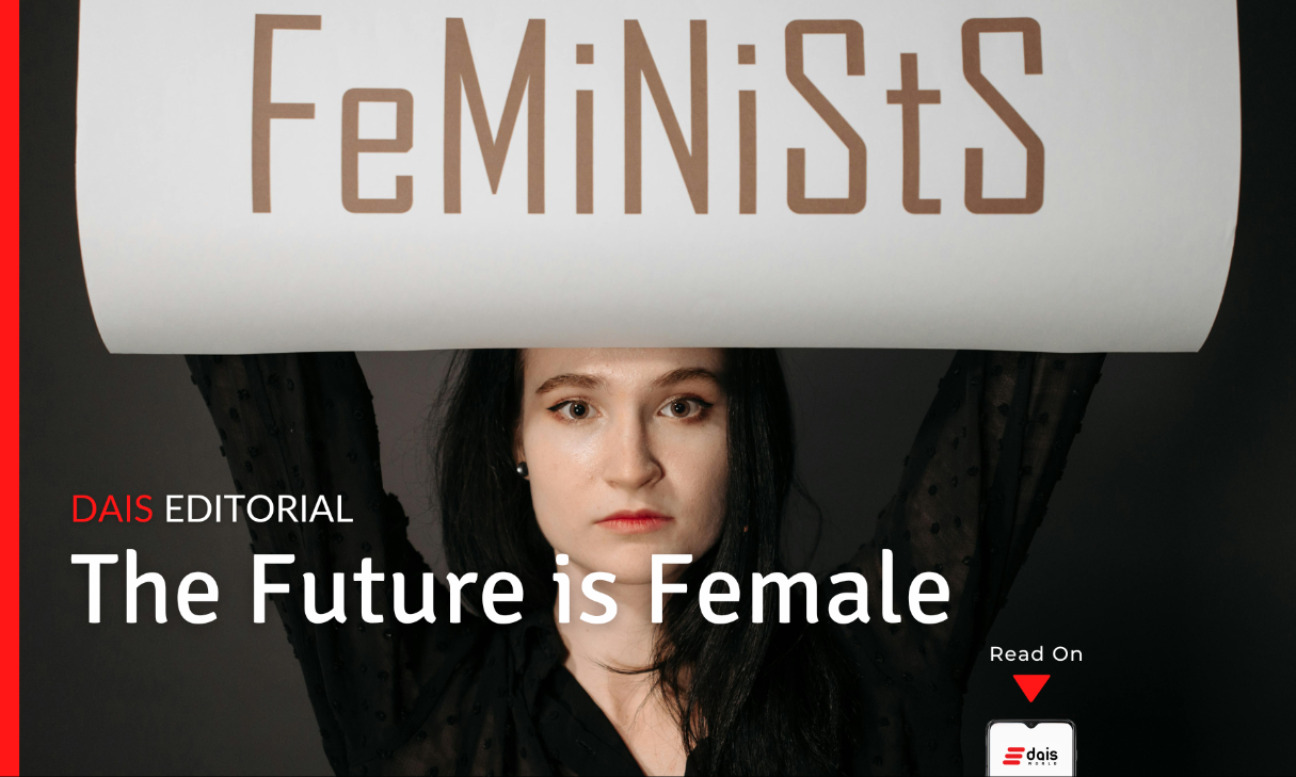Editorial > The Future is Female - Are You a Feminist?
The Future is Female - Are You a Feminist?

Dais Editorial | 14/09/2021 07:02 PM
‘Feminism’
What is the first thought that comes to your mind while you read this word?
Would you believe if we told you that while the textbook definition may be one; opinions, notions and understandings around this word vary for each one of us?
So then, are you a feminist?
The answer to this question rarely stops at a yes or no. It either comes with an emphatic Yes followed by an expression that makes you feel why you ask such a rhetorical question.
Or with a strong Absolutely Not – equating all feminists to man-haters who need to stop complaining and get down to some real work.
Dig a little deeper, and you will often realize that the arguments on either side don’t hold much water. The information is half-baked, the knowledge is perceptive and the opinion is well just that... an opinion, without facts enough to substantiate it.
And THAT to our minds must be the purpose of any informative piece that is structured around this important but polarizing topic. Hence no matter which side you are on, or are perhaps still fence-sitting, waiting for more data to arrive – this is where your journey to self-discovery begins. With facts, not opinions. Read on…
Starting from the start: What gave birth to Feminism?
The term “feminism” originated from the French word “feminisme”. It was coined by the utopian socialist Charles Fourier in the 1980s in association with the movement for equal political and legal rights for women. It referred to “feminine qualities or character,” even though the word isn’t nearly used in that sense anymore.
A broad definition of feminism is adopted in gender studies where feminism is concerned not just with formal equality between men and women but also with everyone's equal access to power and resources. This definition again has its roots in history, which witnessed mass movements aimed at eliminating discrimination and exploitation based on sex and gender.
But it didn’t happen all at once – and never the same way each time either. As a political movement, in fact, feminism is frequently described in waves for a better understanding of how we got here. For many, this form of representation is seemingly reductive. The argument ignores multiple and often simultaneous movements within the race, ethnicity and class by choosing to focus solely on a few famous figures and events.
But to many, this may be a form of formal education on the topic – one that many of us, unless specializing in history or political studies, would rarely receive.

THE FIRST WAVE OF FEMINISM; THE SENECA FALLS CONVENTION
The first wave of feminism is often linked to the first women’s rights convention held in Seneca Falls, New York in 1848. It officially marked the beginning of the American Women’s Suffrage movement which advertised itself as a period of protests against stereotyping of women in domestic roles. It was during the eighteenth century when Lucy Gage, born as a slave, gave her infamous “Ain’t I a Woman?” speech.
“And ain't I a woman? Look at me! Look at my arm! I have ploughed and planted, and gathered into barns, and no man could head me! And ain't I a woman? I could work as much and eat as much as a man—when I could get it—and bear the lash as well! And ain't I a woman? I have borne 13 children, and seen most all sold off to slavery, and when I cried out with my mother's grief, none but Jesus heard me! And ain't I a woman?”
 Feminism in its first stage had a fairly simple but focused objective: To have society recognize that women are human and not property. While initially, the leaders of 1st-wave feminism were abolitionists (including Frederick Douglass and Sojourner Truth), their focus was primarily on white women’s rights. In the United States, first-wave feminism is considered to have ended with the ratification of the 19th Amendment in 1920, granting women the right to vote.
Feminism in its first stage had a fairly simple but focused objective: To have society recognize that women are human and not property. While initially, the leaders of 1st-wave feminism were abolitionists (including Frederick Douglass and Sojourner Truth), their focus was primarily on white women’s rights. In the United States, first-wave feminism is considered to have ended with the ratification of the 19th Amendment in 1920, granting women the right to vote.

THE SECOND WAVE OF FEMINISM; WOMEN’S LIBERATION
The second wave (better known as the Women’s Movement or Women’s Liberation) subsequently occurred in the early 1960s and lasted through the late 1980s. It was a movement for greater social equality for women in education and the workplace.
While the first wave of feminism was set off by western, cisgender, white women; the second phase drew in women of colour seeking righteousness and solidarity. Movements such as National Organization for Women 1966 cohered feminist political activism.
They used language to further their social objectives – a prime example being the use of Ms., rather than Miss or Mrs., to get past the need to reveal marital status (the way Mr. already did for men). Inspired by the Civil Rights movement and protests against the Vietnam War, the second wave of feminism challenged what women’s role in society should be.

 THIRD-WAVE OF FEMINISM; GRRRL STYLE
THIRD-WAVE OF FEMINISM; GRRRL STYLE
The third wave of feminism originated in the early 1990s as a response to the perceived failures of the second wave by questioning "essentialist" definitions of femininity. The third wave of feminism claimed to have focused on the advancement of upper-middle-class white women and not on the specific needs of lower-class women living in other cultures with less power.
With the provenance of punk-powered feminism, The Riot Grrrl movement, and Anita Hill’s sexual harassment case against Supreme Court Justice Clarence Thomas, this era continued to work on the foundation laid by Women’s Liberation while also setting the stage for future generations.
COMING TO HERE AND NOW - FOURTH WAVE OF FEMINISM; #metoo AND WOMEN’S MARCHES
Characterized by the MeToo movement and a resurgence of attacks on women’s rights, Fourth-wave feminism has continued to reckon with intersectionality (“the theory that the overlap of various social identities, as race, gender, sexuality, and class, contributes to the specific type of systemic oppression and discrimination experienced by an individual”). Although debated by some, this movement has grown rapidly with social media activism as its key component.
Feminism has now a broader definition - A political, cultural, or socio-economic movement aimed at establishing equal rights and legal protection for women. The goal of feminism perhaps now seems clearer - to challenge the systemic prejudices women face on a daily basis and to advocate gender equality for women.
In India, we were no different – but our first feminists were in fact, MEN!

An ‘Ideal Indian Woman’ is often a stereotypical character straight out of a saas-bahu drama.
A soft-spoken, adequately educated but non-working, saree-clad, jewellery adorning wife and mother whose haath ka khana is the only thing that binds her family to her. That’s how important her role is purported to be.
Like Shilpa Phadke surmised in her book “Why Loiter?”:
A “good woman does not leave the house unless she has a reason to leave the house”
But to many men in Indian history, this was the exact opposite of what women represented in their familial structures. They openly despised the social evils of sati, prayed to the self-proclaimed social judges to allow widow remarriage, advocated the need to ban child marriage, and strived in uncontemporary ways to reduce illiteracy and bring women to the forefront.
The literary works of writers like Rabindranath Tagore, Balaram Das, Bankim Chandra Chatterjee reflected the need for a shakeup of this unequal construct of social hierarchy in prose. Reformers like Raja Ram Mohun Roy, Swami Dayananda Saraswati, Ishwar Chandra Vidyasagar fought hard against the concept of women being good enough for the kitchen only and advocated an aggressive change in the perceived role of women in Indian society.
The Indian sea of feminism had its waves too...
THE FIRST WAVE (1850-1915)
Feminism as an initiative by women was started a little later by pioneering advocated of women’s rights and education- Savitribai Phule, who started the first schools for girls in India in 1848; Tarabai Shinde, who wrote Purush Tulana- India’s first feminist text by a woman; and Pandita Ramabai, who criticized patriarchy and caste-system.
The First wave of Indian feminism coincided with the colonial period, known as India’s pre-independence era. Women were not provided with equal access to education and were still considered the “property” of their husbands. Feminists in the country began to work towards ridding society of “aberrations” like sati, child marriage and polygamy, the primary ills that halted social accession for Indian women.
And, thus, the Second Wave of Indian feminism emerged, hoping to add new fire to the past reforms of the First Wave.
THE SECOND WAVE (1915-1947)
This period in India saw the contribution and struggle of women against colonial rule. The 1920s was a new era for Indian women and is defined as 'feminism' that was responsible for the creation of localized women's associations. Organisations like the All India Women's Conference (AIWC) and the National Federation of Indian Women (NFIW) emerged.
Women were grappling with issues relating to the scope of women's political participation, women's franchise, communal awards, and leadership roles in political parties. Women's participation in the struggle for freedom developed their critical consciousness about their role and rights in independent India. While the Second Wave of feminism saw great success during a period of national turmoil, it failed to achieve full gender equality.
THE THIRD WAVE (THE POST-INDEPENDENCE ERA)
O n having proven their capability to lead as they strongly participated in the Indian freedom struggle, Indian women were granted the right to vote. But that was all that changed, no more.
n having proven their capability to lead as they strongly participated in the Indian freedom struggle, Indian women were granted the right to vote. But that was all that changed, no more.
During India’s initial attempt at development, women lost a lot of ground – unequal pay, marriages carrying the pre-requisite of dowry, abortion of the female foetus, poor health and sanitation and the list went so on. Thus, the Third Wave in the Indian feminism movement had an important agenda – to remind those in power that women cannot be left behind in the process of building the nation.
The main idea of the third wave is to have a more comprehensive approach than its predecessors. It questions existing patriarchal power structures and social systems– something that the first two movements failed to do.
Of course, the Third Wave brought with it a lot of media and social attention to the subject. The uproar against the Bois Locker Room incident, the popular #MeToo movement, the backlash against Fair & Lovely’s discriminative advertisements, the Supreme Court’s judgment in NALSA - Watershed moments ushering in a new era of Indian feminism were quite aplenty this time around.
But to say that this has got us somewhere meaningful as a society, would still be a tad premature to declare.
It’s not over YET. . .
Justice is about making sure that being polite is not the same thing as being quiet. In fact, oftentimes, the most righteous thing you can do is shake the table.
Alexandria Ocasio-Cortez
For a lot of people, feminism as a movement is now obsolete - After all, women can now vote. They have the power to express themselves and their choices via the rights bestowed upon them by the great Indian democracy! True that. In fact, in a lot of demographics, female voter turnout is more than men.
But voting is not enough. Women need to reach the decision-making echelons of the governmental ladder. Despite reservations and attempts at inclusion - women hold comparatively lesser number of seats in the government.
And even if there is opportunity, the compensation for the job done is not the same. The gender pay-gap is a compelling issue not just in India, but worldwide.
While it is definitely encouraging to know that there are women who feel they have the same opportunities as a man in this day and age – the question still continues to arise.
 If it wasn’t for those who fought for them in the past. would women have been where they are today?? Feminism is not a one-time competition; it is an ongoing war.
If it wasn’t for those who fought for them in the past. would women have been where they are today?? Feminism is not a one-time competition; it is an ongoing war.
It is needed till every woman in the world feels equal and no lesser than any man.
It is needed till patriarchal practices like changing the last name to your husband’s after marriage continue to exist.
It is needed till women continue to be raped, molested, touched inappropriately as they head to work on public transport and fight hard to not be objectified by the prying eyes of the men around them. It is needed till they feel safe to walk home late at night without the fear of being gang-raped and if something untoward were to happen, to be supported by their government and its powers-that-be for the wrong that has happened with them. Rather than being told that “women walking around late at night or wearing western clothes invite men to rape them.”
It is needed till there is a thought that toys are gender-different too – cars for boys and Barbie dolls for girls? No more.
It is needed till terms like b**ch exist for the woman who asserts herself in a professional environment and if she hangs around a bit more with the male colleagues than the others, her character is similar to that of a wh**e.
It is needed till infanticide of the unborn girl child stops. Till the parents don’t accept that it doesn’t matter whether it is a girl or a boy – all children deserve equal love, equal education, equal nutrition and equal opportunity.
However, feminism on social media isn’t the only kind there is, as well-known professor and author Madhavi Menon puts it. The very fact that widespread social media movements are still needed indicates the intensity of the issues faced by women.
While feminism is still associated with negative shifts in power and authority dynamics, social media certainly advocates a more level playing field, allowing for the voices of women from different backgrounds and identities to be heard. Today’s Feminism focuses on the equality of the sexes.
 Despite a plethora of data proving that women are treated unequal to men, many continue to analogize feminism to being anti-men, arguing that women are just playing victim, or that men and women are inherently and biologically different and thus, cannot be compared.
Despite a plethora of data proving that women are treated unequal to men, many continue to analogize feminism to being anti-men, arguing that women are just playing victim, or that men and women are inherently and biologically different and thus, cannot be compared.
Therein lies the difference between the perception of what feminism is and the truth of what it means. As negative connotations around 'Being a Feminist' are scoring high, it becomes crucial for us to understand what feminism stands for. There are many followers as there are detractors of this movement, but for being either meaningfully – one needs to know the basics of where feminism began and where we stand today.
The purpose of this piece is to not only highlight the contribution of women to history and contemporary society but to also remind ourselves of the inherent need to keep women deeply entrenched in the socio-economic fabric of the world. Because now more than ever, the writing is loud and clear on the wall – women belong here and for anyone who thinks otherwise? Well, your Time’s up!

Editor-In-Chief - Abhishek Deb
You were reading a Dais Editorial©2021
Please fill us in with suggestions, feedback, additions and comments here – assist@dais.world.







